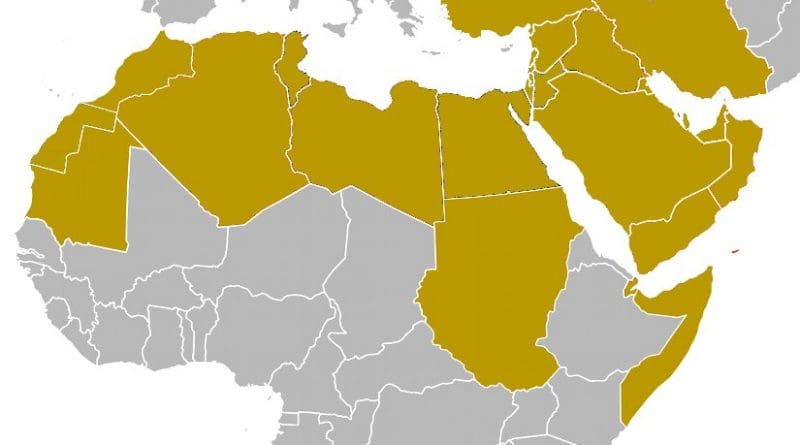MENA Struggles For Growth, Except In GCC – Analysis
By Sajid Rizvi
The Middle East and North Africa region is struggling for continued growth, except in the six Gulf Cooperation Council countries where a different, rosier outlook prevails, says the latest report of a regional economic analysis from the National Bank of Kuwait (NBK).
In its latest roundup dated 14 January 2014, the Kuwaiti institution, a strong presence on MENA’s increasingly fractious, fragmented and volatile financial scene and with significant operations in Europe, NBK says “ongoing challenges in countries undergoing transition – including Egypt, Jordan, Libya, Morocco, Syria, Tunisia and Yemen – will continue to affect economic performance in the MENA region.”
As a bank aiming for apolitical analysis and impartiality it is understandable that NBK lumps all those multiple crises together and characterises everything from civil war, internecine and inter-militia mayhem, post-revolution upheavals, tribal conflicts and random slaughter as “transition.” Germany’s new Foreign Minister Frank-Walter Steinmeier recently called post-Kadhafi Libya “a failed state.”
NATO countries that funded and spearheaded the 2011 attack on Libya wearing a U.N. fig leaf, an expensive, high-velocity intervention that brought down Kadhafi and set off the current cycle of violence in Libya and beyond its borders in Africa and further afield, are now less eloquent and coy (read: dishonest) about what’s going on in the country.
Nor have European voters been told how much the NATO activity in and around Libya cost the taxpayer, is costing. But NBK is right to stick to the nitty gritty and concentrate on the basics of growth, no growth or slow growth.
Although growth could rise to 4 percent in 2014 from 3 percent in 2013, NBK’s analysis says that growth in most “transition” countries will remain below par, averaging closer to 3 percent. While regional and international aid has helped to stabilise transition economies and reduce short-term external funding pressures, better medium-term prospects depend upon achieving the political consensus needed to bolster economic reforms and the return of foreign capital. For many countries, this still seems some way off.
In the GCC, Dubai’s real non-oil growth rate is currently around 5 percent on the back of a rapid expansion in its real estate, tourism, trade and financial sectors.
Elsewhere in the resource-rich GCC region, growth prospects remain favorable, supported by high oil prices, a steady flow of government development spending and – in some cases – an increasingly buoyant private sector. Real GCC non-oil GDP growth is forecast at around 5.5 percent per year in 2014 and 2015, 0.5 percent points higher than in 2013. Qatar will remain the best performer, but the UAE economy – boosted by returning confidence and renewed impetus from infrastructure investment – appears to be improving the quickest.
On the GCC’s continued dependence on oil, the NBK says, “We maintain our forecast for oil prices at $100 per barrel (pb), on average, for 2014, a fall of 8 percent from 2013. Although oil prices held up well last year, continued strong growth in non-OPEC supplies and a potential rise in output from OPEC members Iran, Iraq and Libya are expected to loosen oil market fundamentals in 1H 2014. Key GCC OPEC members – led by Saudi Arabia – are forecast to cut oil output from current elevated levels early in 2014 in order to balance the market. Real oil sector GDP is therefore seen declining 2 percent in 2014, pushing overall GDP growth down to 3 percent.
“Inflation across the GCC region could be pushed higher by a combination of solid growth and rising pressures on housing rents. But at around 3 percent on a weighted basis, it is unlikely to concern policymakers very much. Meanwhile, the decline in oil revenues will reduce the GCC’s aggregate fiscal surplus to 7percent of GDP, from 10 percent in 2013. Although this is still very strong by international standards, we expect GCC countries to pay growing attention to the sustainability of their fiscal positions going forward. This could translate into slower growth in overall spending than before, and tighter curbs on current spending in particular. This, in turn, will have implications for macroeconomic performance in the years ahead.”
In Egypt, which the analysis calls “a pivotal economy for the MENA region” – a combination of capital controls, a managed depreciation of the pound and financial support from the GCC helped ease pressures on the external position in 2013. Along with a slight improvement in the political climate, this has set the stage for a modest acceleration in growth to 3 percent in FY14/15. But major challenges remain. As well as sustaining progress with the political transition, the government must navigate the need to protect living standards and social stability on the one hand, and enact major deficit-reducing fiscal reforms (particularly on subsidies) on the other.
Outside the scope of NBK’s admirable, concise but thorough analysis of the shape of economic things to come in MENA — and, inevitably, its European environs — there remain many questions still unanswered about the regional governments’ responses to urgent issuance of governance and transparency that keep cropping up in materials produced by advocacy groups like Amnesty International, Human Rights Watch and numerous national activist groups. These are disturbing materials that seldom get aired in international media and certainly hardly ever in regional and national bearers of news. Any economist worth his/her salt would know those issues constitute threats to whatever the government planners may be dreaming about or trying to implement.
Copyright © Sajid Rizvi. Reproduced with permission from The Middle East in Europe, www.meenet.info.

